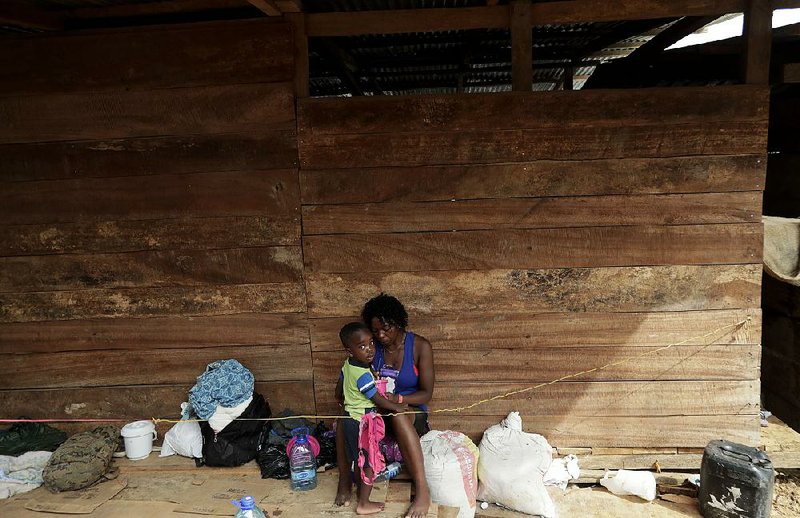PENITAS, Panama -- Panamanian authorities are struggling to contend with a spike in the number of migrants passing through what is known as the Darien Gap, a roadless, lawless region of tropical isthmus that is one of the most dangerous stretches for people heading north from South America, usually toward the United States or Canada.
It's the biggest migratory crisis Panama has faced since 2015-16, when about 60,000 people crossed the Darien Gap, an exodus that prompted governments to temporarily close borders in Panama, Costa Rica and Nicaragua.
According to the National Border Service of Panama, 7,316 migrants went through the Darien Gap this year as of April 18. Such traffic tends to fall off during the imminent rainy season, but the numbers are still on pace to well exceed the 9,678 who made the passage last year and potentially rival 2015-16.
In interviews, the migrants say they are fleeing poverty, misery, discrimination, political conflicts, war and extremist violence.
"I think what is happening at the Colombian-Panamanian border is a reflection of what is happening on an international level. ... It is a search for hope, for opportunities, for well-being, for a vital minimum that is not being provided by the state where they come from," said Johanna Fernanda Navas, a researcher on migration and human rights at the Catholic University of Colombia.
Most in the surge in Panama are migrants from Haiti or Cuba, with smaller numbers coming from African nations such as Cameroon and Congo, plus the South Asian countries of India, Bangladesh and Sri Lanka.
Cubans have for years flown to Ecuador to begin their journey, though recently many have begun to opt for abbreviated routes beginning in Panama or Nicaragua. Haitians went to South America years ago after their country's disastrous 2010 earthquake, more recently deciding to move on when work dried up.
"Our jungle is a bad jungle. ... That journey is very dangerous [with] unscrupulous people, 'coyotes,' who guide them through the jungle and abandon them to fate," said Jose Samaniego, eastern brigade chief for the Panama border agency in the town of Meteti, one of the last outposts along the Pan-American Highway.
The Darien Gap's perils are numerous. Tales are common of robberies and sexual assault by marauding bands of armed Colombians and Panamanians, and encounters with the drug-trafficking "mules" who walk the same paths as the migrants.
"The jungle aspect of it was so terrible because it was the survival of the fittest, you understand?" said Afolabi Ojo, who fled his home in northern Nigeria after the extremist group Boko Haram killed his family. "The environment was so deadly. You can imagine somebody coming from the bush, from the forest."
Rivers in the Darien region can rise suddenly and furiously, and in recent weeks at least 10 migrants were reportedly swept to their deaths. Samaniego said the toll could be higher, but there is no way of knowing given the remote and unforgiving nature of the area.
The International Organization for Migration's Panama branch says migrants who traverse the Darien jungle often arrive "in very bad shape." The Panama border agency says the most common maladies are diarrhea, throwing up, skin inflammation, foot mold and dehydration.
Emerging from the Darien Gap, most migrants pass through the hamlets of Bajo Chiquito or Canaan Membrillo before making their way by foot or by boat along the Chucunaque River to Penitas.
In normal times, Penitas is an indigenous village with fewer than 200 inhabitants who ply the river in narrow wooden skiffs. They have no running water, cellphone coverage, medical clinic or regular transportation.
These days Penitas is overwhelmed by migrants, who sleep on bunk beds and floor mats in a warehouse or outside in tents. They wash clothes in the muddy waters of the Chucunaque, hang things to dry on clothes lines and chain link fencing and relieve themselves in blue portable toilets set up outside the shelter.
Samaniego estimated on a recent day that there were more than 1,500 migrants at the Penitas camp, which was planned to hold only 100 to 200 and just a few months ago was housing around 80 or 90 on a given day.
Although most of the travelers hope to get to North America, some said they were applying for refuge in Panama.
One of them was Lisandra Perez Molina, a 24-year-old from Santa Clara, Cuba. She gave birth April 14 in an indigenous village before arriving in Penitas and a month later was tired of waiting at the crowded shelter.
"What I want is for them to get me out of here," Perez said as the boy slept in diapers inside a tent next to his brother Yusnel, 1.
"My boy has rights here, and we as parents have them, too," Perez said.
She held up the birth certificate inscribed with the name of her Panama-born son: Darien.
A Section on 05/17/2019

